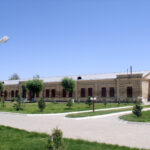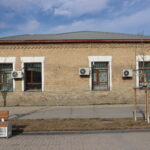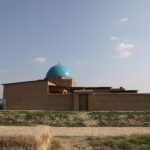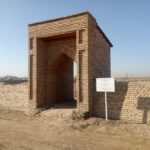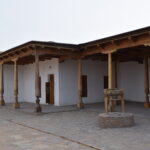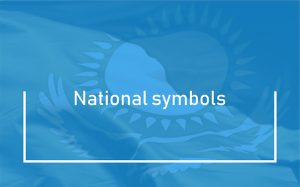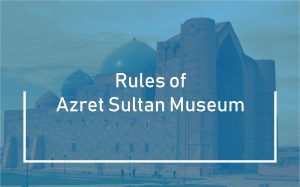According to written sources, Jangir khan was born according to following infromation: Genghis khan – Jochi khan – Orda Ichen – Sartaktay – Bayan – sasybuka – Erzen – Timtay – Orys khan – Koyirchak – Barak khan – Janibek Khan – Djadik sultan – Shygai khan – Esim khan – Jangir khan (Rashid-al-Din, 1941: 41–48). Jangir khan was one of three famous sons of Esim khan (Sultanov, 2001: 221–222.). The eldest Esim khan’s son was Janibek Sultan, second Jangir khan, third Syrdak sultan. In the view of T.I. Sultanov, Janibek, the eldest of Esim khan’s sons ruled in early 30-s of XVII century. He waged wars with oirat thais and died in early 40-s of XVII century in one of battles (Sultanov, 2001: 221–222). Syrdak Sultan had son, Husyrau sultan, whose son is known as Kaip khan. No information found on exact birth date of Jangir khan. Presumably, he was born at the end of XVI or beginning of XVII century. Jangir’s real name was Jahangir (from Persian “world conqueror, ruler”). The pronunciation of his name was changed as per specificity of Kazakh language. Jangir khan was small height and a well-developed body. That was why people called him “Salkam Jangir”. Jangir khan’s name (Jahangir) first appears with events related in the mid ‘30-s of XVII century in east sources and materials in Russian language. According tho those sources he mentioned as sultan (Materials according to the history of Russian and Mongolian relations, 1959: 174–175, 207, 234, 239, 276, 278). The East book “Bahr al-asrar” written in medieval times, Jahangir sultan mentioned as Kazakh sultan, who in 1634 organized campaign to Tashkent (Sultanov, 2001: 223). According to the materials of Russian and Mongolian relations of XVII century, we know that in 1635 the oirats captured him in one of the battles. The most common fact of Jahangir khan’s life were battles in 1643. In reports from Russian ambassadors who visited Dzungaria, he was called sultan. For example, as per materials of Russian scientists, in September 1640 ambassador of Kazakh sultan Jangir visited orda of Dzungarian Khong Tayiji (Zlatkin, 1983: 129). Batyr of Khong Tayiji started his military campaign against Kazakh people in winter of 1643 and lasted to the mid-summer of 1644. Many oirat thais were on the side of dzungarian ruler, including son of the ruler Halhi Ombo-Erdeni. 50 thousand troops went along warpath against Kazakh people. Bahtyi, the ambassador testifies that Jangir khan allies, Hundulen tayshy and sons of Dalay tayshy refused to join the warpath. G. Ilyin emphasized Batyr Khong Tayiji’s campaign against Jangir sultan in his materials. There are no records about Janibek, brother of Jangir khan. Only Jangir sultan is mentioned across different sources. Such situation reminds of historical role, Kazakh sultan Abylai played in 40–60s of XVIII century. Jangir sultan was informed of Dzungarian army to confront against Kazakh people. It was all due to friendship between Jangir and Hundulen taiyshy. Thus, knowing the direction of Batyr Khong Tayiji’s campaign in advance, Jangir sultan decided to choose a best place for the future battle. Jangir sultan informs his friend Jalantos batyr from Samarkan. Having squadron of 600 people with firearms, matchlock guns, Jangir sets out. Understanding that in open combat he would not be able to resist 50 thousand army of Batyr Khong Tayiji, Jangir used new tactic, non-standard for nomads. He ordered to dig a deep moat on the way of Dzungarian army across narrow mountain gorges, followed by high earth berm, where Jangir khan left 300 warriors on a stakeout, while he and rest of army placed on a mountain slopes on both sides of gorge. When army of Khong Tayiji approached the ambush side, 300 warriors hidden in the trenches opened fire and stopped the enemy. Sultan with rest of warriors attacked the enemy from the other side. The narrow gorge prevents Kalmyk army from maneuver and use their numerical superiority. Batyr Khong Tayiji attacked twice but in vain. By that time, 20-thousand army of Samarkan akim Zhalantos batyr came for help. Losing about 10 thousand warriors, Dzungarian army found no way out than retreat (Zlatkin, 1983: 129). That glorifying jangir sultan’s battle undermines the authority of Batyr Khong Tayiji. There are no exact year Jangir became khan. In this regards, T.I. Sultanov draw conclusions: “Around mid 40s of XVII century, Jahangir becomes khan of Kazakh people after Janibek’s, his brother’s death” (Sultanov, 2001: 223.). We might consider Jahangir became khan in 1643/44. Before he took power, he was respected by Kazakh people, and was the one to become khan of Turkestan after his brother, quite rightly. We don’t know what policy Jangir pursued as khan. In manuscripts he is pictured riding a horse battling with enemies in far warpaths. During the ruling of Jangir khan, Kazakh khanate had good relations with Mongolian rulers of East Turkestan. The history of bilateral relations formed in early XVI century and developed in different ways. With Tauekel and Esim khans those relations become stronger, while Jangir khan continued and developed it. Being defeated in 1643–44, in 1652 Batyr Khong Tayiji decides to kill Jangir khan by all means. He prepares special archers-shooters and orders them to reach Kazakh khan as close as possible and kill him. The task was fulfilled by 17 year old Galdamba. Jangir khan’s death described in “Lunar light: history of Rabjama Zaya Bandida”. It says that “second son of Otchirt Tsetsen khan, a 17 year old Galdama in 1652 killed Jangir khan in a battle with Kazakh people”. There is not the slightest prospect for it was a duel. Another source says that: “During campaign, Galdama was 17 years younger than Jangir. He kills Jangir (Iyangir) khan with a sword”. Possibly he hit his back. However, they wouldn’t let duel with Jangir khan, because it was the law of war. Galdamba wasn’t from commoner either. He was the 17 descendant of Havta Hasar, his father, Otchirt Tsetsen (Chechen) was chief thai of Dzungarians. Kazakh khan Jangir fought for freedom, independence of his people, protected native land and died in a bloody battle like a real warrior. Jangir khan buried next to mausoleum of Khodja Ahmed Yasawi in Turkestan. His father Esim khan, uncle Ondan sultan, brother Zhanibek khan and other famouse figures were buried before Jangir khan by the walls of mausoleum. We consider that Jangir khan burial in the city was continuation of early tradition.
JANGIR KHAN ESIM ULY


